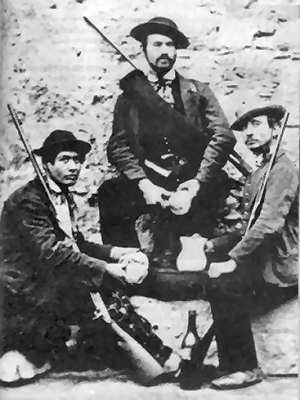Brigands
THE TUSCANY AND LAZI MAREMMA HAS BEEN A LAND OF BRIGANDS FOR CENTURIES. BRIGANTAGE IS A SOCIAL PHENOMENON THAT EXPLODED ALSO THANKS TO THE REPOPULATION PLAN DESIRED BY LEOPOLD II OF LORRAINE WITH THE CLEANING OF 1828.
The unification of Italy – 1860-1861 – caught the Maremma in one of its darkest historical moments: malaria, illiteracy, poverty, delinquency, exploitation of labourers, strong popular discontent. In this framework the phenomenon of brigandage, thanks to the population plan implemented by Leopold II of Lorraine in history Reclamation of 1828, which allowed convicts from other Italian states (provided they had not committed too serious crimes) to take refuge throughout the area and live freely, repopulating the territory which had previously been “unlivable” due to the sanitary conditions of the environment. The terrible bite of the Anopheles mosquito, carrier of malaria, was transmitted extremely easily. Brigandage characterized, together with malaria, the period of the bitter Maremma, painfully expressed in the famous popular song of the first decades of the nineteenth century (“Maremma amara”) which denounced all the cruelty of such a harsh and deadly territory. The brigandage of the Tuscan and Lazio Maremma was experienced by many locals as a “positive” phenomenon (contrary to what one might imagine), because it represented an act of freedom and rebellion against the miserable living conditions and centuries-old injustices. The law, at that time, was almost always fair only to the nobles and wealthy. The greatest violence almost always occurred against carabinieri, farmers, guardians, landowners and other figures who generally symbolized power and the new Italian state recently proclaimed. A really tough period in Maremma.
Domenico Tiburzi and the Maremmani Brigands
In the Tuscan and Lazio Maremma the phenomenon of brigandage was embodied more than anyone else by the legendary Domenico Tiburzi, also known as “Domenichino” or “the King of Lamone and Montauto” or “the Leveller of the Maremma”. After more than twenty years of hiding and continuous battles against the law, he had become one of the most popular and wanted bandits in Italy. Tiburzi was much loved by the population who considered him a protector and benefactor of poor people, his deeds were interpreted as romantic actions to make amends for the many social injustices of the time. Many other brigands, besides Domenico Tiburzi, left their trail of terror in the territories of the Tuscan and Lazio Maremma: Enrico Stoppa, Damiano Menichetti, Antonio Ranucci, Settimio Albertini, Fortunato Ausini, Settimio Menichetti, Luciano Fioravanti, among the most famous brigands.
Resources on the Maremma Brigands
- Brigands in Maremma – Overview of banditry in the Maremma.
- Museum of Banditry of Cellere – Set up on two floors, the museum offers the visitor many historical documents (of various kinds) on the phenomenon of banditry in the Maremma and Lazio regions of the late 19th and early 20th centuries.

